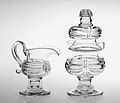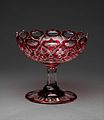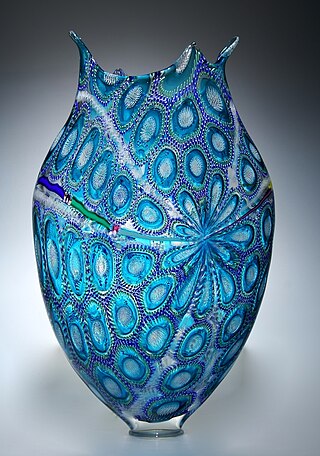
Studio glass is the modern use of glass as an artistic medium to produce sculptures or three-dimensional artworks in the fine arts. The glass objects created are intended to make a sculptural or decorative statement, and typically serve no useful function. Though usage varies, the term is properly restricted to glass made as art in small workshops, typically with the personal involvement of the artist who designed the piece. This is in contrast to art glass, made by craftsmen in factories, and glass art, covering the whole range of glass with artistic interest made throughout history. Both art glass and studio glass originate in the 19th century, and the terms compare with studio pottery and art pottery, but in glass the term "studio glass" is mostly used for work made in the period beginning in the 1960s with a major revival in interest in artistic glassmaking.
Owens Corning is an American company that develops and produces insulation, roofing, and fiberglas composites and related materials and products. It is the world's largest manufacturer of fiberglas composites. It was formed in 1935 as a partnership between two major American glassworks, Corning Glass Works and Owens-Illinois. The company employs approximately 19,000 people around the world. Owens Corning has been a Fortune 500 company every year since the list was created in 1955. The Pink Panther acts as the company's mascot and appears in most of their advertisements.

O-I Glass, Inc. is an American company that specializes in container glass products. It is one of the world's leading manufacturers of packaging products, holding the position of largest manufacturer of glass containers in North America, South America, Asia-Pacific and Europe.

Edward Drummond Libbey is regarded as the father of the glass industry in Toledo, Ohio, where he opened the Libbey Glass Company in 1888.
Irving Wightman Colburn was an American inventor and manufacturer.

Libbey-Owens-Ford Company (LOF) was a producer of flat glass for the automotive and building products industries both for original equipment manufacturers and for replacement use. The company's headquarters and main factories were located in Toledo, Ohio, with large float glass plants in Rossford, Ohio, Laurinburg, North Carolina, Ottawa, Illinois, Shreveport, Louisiana, and Lathrop, California. The company was formed in 1930 by the merger of Libbey-Owens's sheet-glass operation with the Edward Ford Plate Glass Company, both located in Toledo.

Michael Joseph Owens was an inventor of machines to automate the production of glass bottles.

Dominick Labino was an American internationally known scientist, inventor, artist and master craftsman in glass. Labino's art works in glass are in the permanent collections of more than 100 museums throughout the world. Labino held over 60 glass-oriented patents in the United States.

The Edward D. Libbey House is a historic house museum at 2008 Scottwood Avenue in Toledo, Ohio. Built in 1895, it was the home of Edward Libbey (1854-1925), a businessman who revolutionized the glass making industry in the United States. Libbey and his wife, Florence Scott Libbey would later establish the Toledo Museum of Art in 1901.
The Fostoria Glass Company was a manufacturer of pressed, blown and hand-molded glassware and tableware. It began operations in Fostoria, Ohio, on December 15, 1887, on land donated by the townspeople. The new company was formed by men from West Virginia who were experienced in the glassmaking business. They started their company in northwest Ohio to take advantage of newly discovered natural gas that was an ideal fuel for glassmaking. Numerous other businesses were also started in the area, and collectively they depleted the natural gas supply. Fuel shortages caused the company to move to Moundsville, West Virginia, in 1891.
Early American molded glass refers to glass functional and decorative objects, such as bottles and dishware, that were manufactured in the United States in the 19th century. The objects were produced by blowing molten glass into a mold, thereby causing the glass to assume the shape and pattern design of the mold. When a plunger rather than blowing is used, as became usual later, the glass is technically called pressed glass. Common blown molded tableware items bearing designs include salt dishes, sugar bowls, creamers, celery stands, decanters, and drinking glasses.
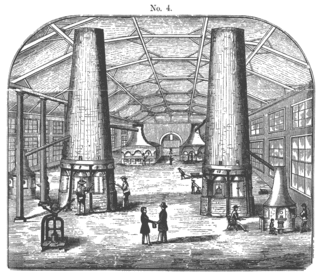
Deming Jarves (1790–1869) was a 19th-century American glass manufacturer in Massachusetts. He has been called the "father of the American glass industry". Jarves joined the glass industry in 1809 when he, with a group of investors, gained control of the window glass company Boston Crown Glass. During the War of 1812, American glass manufacturers lost access to high–quality sand and red lead, which was an essential ingredient for high–quality glass. After the war, British manufacturers began dumping low–priced glass in the United States. This caused many American glass manufacturers, including Boston Crown Glass, to go out of business. In 1818 Jarves and an investor group found the New England Glass Company, where Jarves researched ways to produce red lead using domestic sources. By 1819 he was producing red lead, which enabled the production of better quality glass.

Hartford City Glass Company was among the top three window glass manufacturers in the United States between 1890 and 1899, and continued to be one of the nation's largest after its acquisition. It was also the country's largest manufacturer of chipped glass, with capacity double that of its nearest competitor. The company's works was the first of eight glass plants that existed in Hartford City, Indiana during the Indiana Gas Boom. It became the city's largest manufacturer and employer, peaking with 600 employees.
J. H. Hobbs, Brockunier and Company was one of the largest and best-known manufacturers of glass in the United States during the 19th century. Its products were distributed worldwide. The company is responsible for one of the greatest innovations in American glassmaking—an improved formula for lime glass that enabled American glass manufacturers to produce high-quality glass at a lower cost. The firm also developed talented glassmakers that started glass factories in Ohio and Indiana.

Pairpoint Glass Company is an American glass manufacturer based in Sagamore, Massachusetts. It is currently the oldest operating glass company in the United States.
Indiana Glass Company was an American company that manufactured pressed, blown and hand-molded glassware and tableware for almost 100 years. Predecessors to the company began operations in Dunkirk, Indiana, in 1896 and 1904, when East Central Indiana experienced the Indiana gas boom. The company started in 1907, when a group of investors led by Frank W. Merry formed a company to buy the Dunkirk glass plant that belonged to the bankrupt National Glass Company. National Glass was a trust for glass tableware that originally owned 19 glass factories including the plant in Dunkirk. National Glass went bankrupt in 1907, and its assets were sold in late 1908.
Jack K. Paquette was a historian, author, and retired vice president of Owens–Illinois. He was born in East Toledo, Ohio, and attended the Ohio State University where he earned a Bachelor of Arts degree in journalism in 1949 and a Master of Arts degree in political science in 1951. After graduation he began a 33–year career with Owens–Illinois, one of the largest glass bottle manufacturers in the world. By 1970 he was vice president of the overall company and director of the Corporate Relations Department. He retired in 1984. During his retirement, he wrote six books about life in Northwest Ohio, including four related to glassmaking.

Very few 19th Century glassmaking innovations in the United States happened at the beginning of the century. Only ten glass manufacturers are thought to have been operating in 1800. High-quality glassware was imported from England, and glassmaking knowledge was kept secret. England controlled a key ingredient for producing high–quality glassware and kept its price high—making it difficult for American glass manufacturers to compete price-wise. European glassmakers with the knowledge to produce high–quality glassware were, in some cases, smuggled to the United States. Eventually the American glass industry grew, and the second half of the century saw numerous innovations.
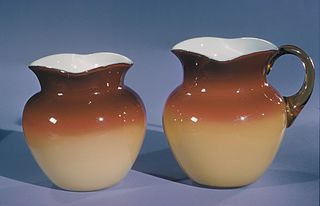
19th century glass categories in the United States include types of glass and decoration methods for glass. A simplified category version appropriate at the beginning of the century is glassware, bottles, and windows. As the century progressed, glass production became more complex and made necessary more categories and subcategories. An 1884 United States government report used glassware, bottles, windows, and plate glass as major categories—although plate glass accounted for only four percent of the value of all glass made.

19th century glassmaking in the United States started slowly with less than a dozen glass factories operating. Much of the nation's better quality glass was imported, and English glassmakers had a monopoly on major ingredients for high–quality glass such as good–quality sand and red lead. A tariff and the War of 1812 added to the difficulties of making glass in America. After the war, English glassmakers began dumping low priced glassware in the United States, which caused some glass works to go out of business. A protective tariff and the ingenuity of Boston businessman Deming Jarves helped revive the domestic glass industry.







